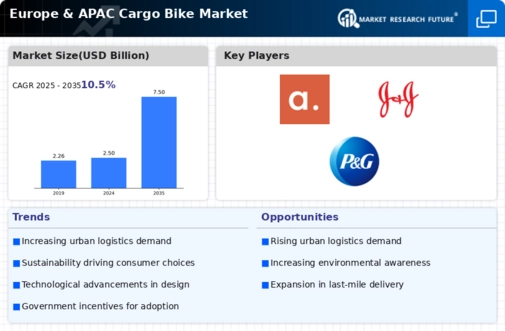E-commerce Growth
The rapid growth of e-commerce is significantly influencing the Global Europe and APAC Cargo Bike Market Industry. As online shopping continues to expand, the demand for last-mile delivery solutions is increasing. Cargo bikes offer an efficient and environmentally friendly option for delivering goods in urban areas. Companies like Deliveroo and Uber Eats are integrating cargo bikes into their delivery fleets, capitalizing on their maneuverability and lower operational costs. This trend is expected to contribute to a compound annual growth rate of 10.5% from 2025 to 2035, underscoring the potential of cargo bikes to meet the evolving logistics needs of the e-commerce sector.
Growing Urbanization
The Global Europe and APAC Cargo Bike Market Industry is experiencing a notable surge due to increasing urbanization. As cities expand, the demand for efficient and sustainable transportation solutions rises. Urban areas are becoming congested, prompting local governments to promote cargo bikes as a viable alternative to traditional vehicles. For instance, cities like Amsterdam and Copenhagen have integrated cargo bikes into their urban logistics, reducing traffic congestion and emissions. This trend is reflected in the market's projected growth, with an estimated value of 2.5 USD Billion in 2024, indicating a shift towards eco-friendly transport solutions in densely populated regions.
Market Growth Projections
The Global Europe and APAC Cargo Bike Market Industry is projected to experience robust growth, with significant market value increases anticipated over the coming years. The market is expected to reach 2.5 USD Billion in 2024, with a remarkable compound annual growth rate of 10.5% forecasted from 2025 to 2035. This growth trajectory suggests a rising acceptance of cargo bikes as a mainstream transportation solution in urban settings. The increasing emphasis on sustainability, coupled with the expansion of e-commerce and supportive government policies, positions the cargo bike market for continued expansion in both Europe and the Asia-Pacific regions.
Sustainability Initiatives
Sustainability initiatives are driving the Global Europe and APAC Cargo Bike Market Industry forward. Governments are increasingly implementing policies aimed at reducing carbon footprints and promoting green transportation. For example, various European countries have introduced subsidies for cargo bike purchases, encouraging businesses to adopt these eco-friendly vehicles. This aligns with the broader global movement towards sustainable urban mobility. The market is expected to reach 7.5 USD Billion by 2035, reflecting a growing commitment to environmental sustainability and the potential for cargo bikes to play a pivotal role in achieving climate goals.
Technological Advancements
Technological advancements are reshaping the Global Europe and APAC Cargo Bike Market Industry. Innovations in electric bike technology, battery efficiency, and cargo capacity are enhancing the appeal of cargo bikes for both consumers and businesses. Electric cargo bikes, in particular, are gaining traction due to their ability to transport heavier loads over longer distances without compromising on speed. This technological evolution is likely to attract a broader customer base, including logistics companies and urban dwellers seeking sustainable transport options. As a result, the market is poised for substantial growth, with projections indicating a value of 2.5 USD Billion in 2024.
Government Support and Incentives
Government support and incentives are crucial drivers of the Global Europe and APAC Cargo Bike Market Industry. Various governments are recognizing the potential of cargo bikes to alleviate urban congestion and reduce emissions. Initiatives such as tax breaks, grants, and infrastructure investments are being implemented to encourage the adoption of cargo bikes. For instance, cities in Germany and the Netherlands have established dedicated cycling lanes and parking facilities for cargo bikes, fostering a supportive environment for their use. This proactive approach is likely to sustain market growth, contributing to an anticipated market value of 7.5 USD Billion by 2035.














Leave a Comment